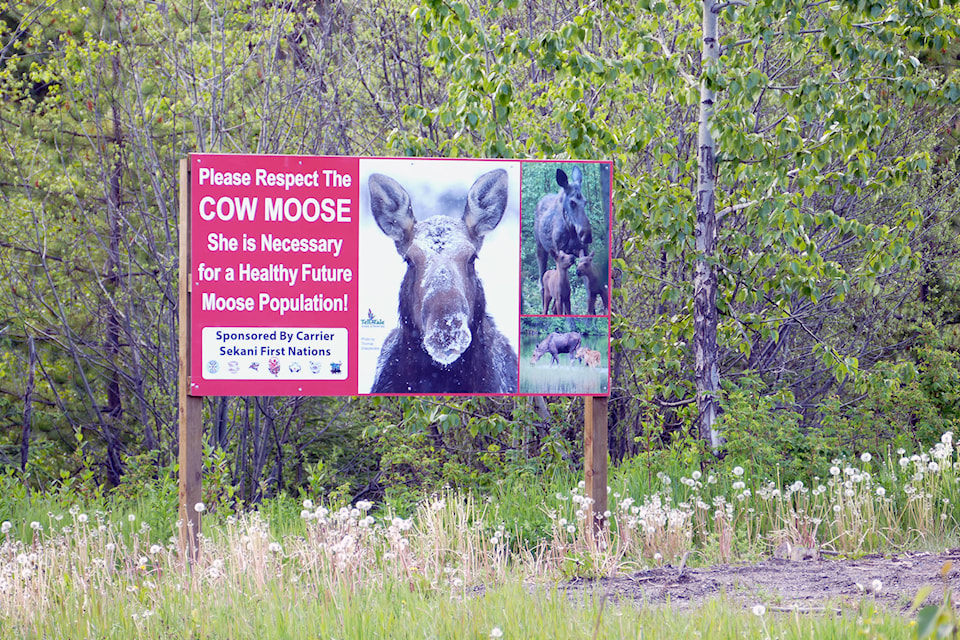There will be a harvest season this year for cow moose and calves in the Kootenay and Omineca regions, the Ministry of Forests, Lands, Natural Resources Operations (FLNRO) has confirmed. Specifically the harvests will be opened in the Revelstoke area, and Parsnip, north of Prince George.
Earlier last week, the B.C. Liberal party sounded an alarm over a leaked NDP memo and suggested that there would be culling of cow moose and calves in order to save the caribou population. The memo indicated that the recovery of the mountain caribou was a top government priority and in order to secure their population, removing a few moose was a “worthwhile trade-off.”
“We had steady declines in moose population and significant declines in main areas around the province. Because the government’s priority is caribou, they are willing to accept the decline of moose and I find that unacceptable,” said B.C. liberal MLA John Rustad.
When asked about the culling by Lakes District News, the government categorically denied that there would be any culling however, they confirmed that the ministry would be issuing hunting licenses this year. A total of 400 authorizations across B.C. will be issued, which is an increase from last year’s 357. The harvest season will begin on Oct. 16 and would carry on until Dec. 10 however the exact duration would vary for each region.
Corrina Leween, the Chief for the Cheslatta Carrier Nation said, “A lot of our people don’t hunt anymore because we are trying to regulate for future generations, trying to get the population back and then we hear that they are opening harvest season out there. Cheslatta is in strong opposition of that.”
The government believes that the management of the cow moose and calf population with a harvest would help reduce predator population, mainly wolves and therefore reduce the threat to the caribou population.
Rustad maintains the moose harvest “makes no sense whatsoever. Wolves will simply go and hunt for food elsewhere, which will be caribou. If wolves are the problem then we have to reduce the wolf population. We don’t need to be reducing the moose population to do that,” said Rustad.
Leween agreed with Rustad, saying that “If anything, perhaps the predators should be concentrated on, rather than the moose” as otherwise the wolves would just go after other animals.
RELATED: Village bids to boost moose numbers
According to a 2019 government release, predator reduction for caribou recovery was also being considered in conjunction with primary prey management i.e. cow moose harvest. In fact, the forest ministry has confirmed that wolf culling will take place this year in the Kootenay Region and Omineca Region, with 10 wolves to be culled in Revelstoke and 91 in the Parsnip area. This endeavour will cost $156, 000 in Revelstoke and $173, 000 in the Parsnip area. The ministry added that such predator management was essential to the survival of the caribou in the short-term.
The forest ministry said that the moose harvest is not new and the “wildlife management action has been occurring in the Parsnip Valley and northwest of Revelstoke for over a decade.” They also added that in the last five years, approximately 77 per cent of cow or calf moose hunting authorizations had been allocated to caribou recovery areas and that has been expanded to include the Kootenay Region and Omineca Region.
While the total number of cow calf harvest has declined from 584 in 2011 to 79 in 2019, and the cow calf harvest is now mostly focused in the caribou recovery areas, from 28 in 2011 to 74 in 2019, it is still a concern for many.
Rustad said, “What is concerning of course, is that there are many caribou areas around the province including the Burns Lake area, the Tweeedsmuir area locally. And if the government thinks that the right thing to do is reduce moose in order to save caribou, I worry that it may extend to beyond what they are currently doing.”
Chief Leween has been a staunch supporter of the moose recovery bid and expressed her disapproval over the process, insisting that the right way to go about this would be through dialogue with the locals living on the lands, with the First Nations elders.
“Our elders know when you hunt the moose, when you don’t hunt the moose, and what you take and what you don’t take. That knowledge is not something you read in a textbook. So, what needs to happen is that the government needs to provide dialogue with the affected First Nations communities and explain what their logic is, what their plans are for the future in regards to the cow and the calf season being opened.”
ALSO READ: Cheslatta backs village on moose recovery bid
Priyanka Ketkar
Multimedia journalist
@PriyankaKetkar
priyanka.ketkar@ldnews.net
Like us on Facebook and follows us on Twitter.
Want to support local journalism during the pandemic? Make a donation here.
